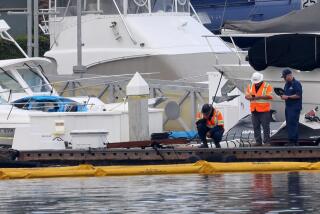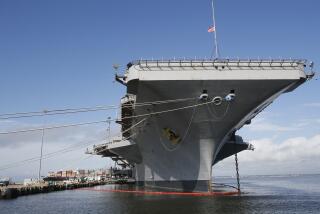Gunpowder Ignition During Loading May Be to Blame : Explosions Rare in Navies’ Biggest Guns
- Share via
WASHINGTON — The 16-inch guns involved in Wednesday’s disaster aboard the Iowa have been a standard fixture on U.S. Navy battleships since the early part of the century--and, surprisingly, have not changed much in concept since they were first deployed.
The guns are the largest still in use by any navy, either of a Western country or a Communist Bloc nation. And the ships that carry them--the 45,000-ton “battlewagons” of naval lore--are the Navy’s oldest and most romantic warships.
The turret on which the guns are mounted is a rotating gun platform that extends down into the ship in the form of a huge cylinder. The cylinder itself has decks on several levels. The guns’ ammunition is stored here and in compartments--called magazines--along the cylinder side.
Silk Bags of Gunpowder
The ammunition looks something like a very long bullet that has been cut into small pieces. The head--or projectile, as it’s called--is loaded into the breech (the rear) of the gun-barrel first. Behind it comes the powder--in six cylindrical 110-pound silk bags.
To fire the projectile, the gun crew sets off a primer--essentially a blank cartridge that in turn explodes to light a special igniting powder that generates enough fire to make the gunpowder explode. The explosion from the gunpowder propels the projectile to its target.
The projectile and the bags of gunpowder are hoisted by separate elevators from their storage compartments in the lower part of the cylinder. A pneumatic ram packs the various components into the barrel before firing. Each gun crew has its own walled-in compartment.
Turret explosions, especially involving 16-inch guns, are rare. “I can’t even recall one that ever happened before,” said Al Carney, who served as commanding officer of the Missouri from 1986 to June of last year.
Three Malfunctions Described
Naval experts say turret explosions usually can be traced to one of three malfunctions:
--If the powder bags are loaded so that the igniting powder is pointing away from the primer rather than toward it, the result could be a “hangfire.” The gunpowder would not explode, but it could be consumed in a slow, smoldering fire that could prove dangerous.
--If the gun crew inadvertently leaves bits of burning debris in the barrel from the powder bags that were used in firing the previous round, they could set off the next round prematurely. Powder bags are made of silk because it burns more completely than other fabrics, but some smoldering residue is possible.
--If the powder ignites accidentally, either in the powder hoist or in the handling room at the base of the turret, the result could be tragic. Because so many men--47 at last count out of a 71-man turret crew--were killed in the accident, speculation is that the Iowa suffered just such a mishap.
Loading Accident Suspected
“For 47 people to have died, the explosion would have to have occurred somewhere in the loading cycle,” Carney said Wednesday.
David R. Cox, a retired Navy captain who served aboard the Iowa as a midshipman, said the flooding reported in the Iowa’s turret could have been intentional. Crews traditionally flood compartments in disabled turrets to prevent any fire from spreading.
The ammunition is large and unwieldy by any standard. Each projectile for a 16-inch gun weighs 2,700 pounds. The 110-pound powder bags are 16 inches in diameter and about a foot and a half in length.
Rear Adm. Gene La Rocque, a highly decorated World War II veteran who serves as director of the Center for Defense Information in Washington, told Reuters on Wednesday that most often “sparks traditionally set old-fashioned bag ammunition off.”
Once the blast occurred, he said, the turret had to be sealed off and the men inside had no chance to get out. “There is no escape for anyone from the fire, the heat, the blast, the debris,” he said. “The battleship turret is a giant steel tomb.”
MAJOR NAVY ACCIDENTS
These were among the major explosions, fires, collisions and similar disasters in the Navy in this century:
Oct. 1, 1972--During the Vietnam War, there was an explosion in the center gun of turret No. 2 of the heavy cruiser Newport News during shore support operations, killing 20 crewmen and injuring 36.
June 2, 1969--Destroyer Frank E. Evans collided with Australian carrier Melbourne in South China Sea, killing 74.
May 21, 1968--Nuclear submarine Scorpion sank in the Atlantic with 99 aboard.
July 29, 1967--Fire ravaged the aircraft carrier Forrestal off the coast of Vietnam, 134 died.
Oct. 26, 1966--Aircraft carrier Oriskany caught fire in the Gulf of Tonkin, with 43 deaths.
April 10, 1963--Submarine Thresher sank in the Atlantic, killing 129.
Dec. 19, 1960--Aircraft carrier Constellation caught fire at her berth in New York City. There were 50 fatalities.
May 26, 1954--Aircraft carrier Bennington exploded and burned near Quonset Point, R.I., killing 107.
April 26, 1952--Destroyer Hobson collided with the carrier Wasp in the Atlantic and sank, killing 175 sailors.
April 21, 1952--Powder explosion occurred in a gun turret aboard the cruiser St. Paul during the Korean War; 30 died.
November, 1943--Battleship Mississippi, while shelling Makin Island in World War II, had an explosion in turret No. 2. Forty-three died.
More to Read
Sign up for Essential California
The most important California stories and recommendations in your inbox every morning.
You may occasionally receive promotional content from the Los Angeles Times.










